This summer, Joanne Schmidt, Glenbow’s Curator, Indigenous Studies & World Cultures, travelled to Talurjuaq/Taloyoak, Nunavut as part of the planning process for an upcoming exhibition focused on Arnaqarvik ᐊᕐᓇᖃᕐᕕᒃ – a women’s craft collective formed in the early 1970s and celebrated for their work with natural dyes. This exhibition will debut in Glenbow’s revitalized home, the JR Shaw Centre for Arts & Culture, upon reopening.
In recognition of International Inuit Day, we sat down with Joanne to learn more about her visit, her conversations with the artists and their families, and how these relationships will shape the future exhibition.
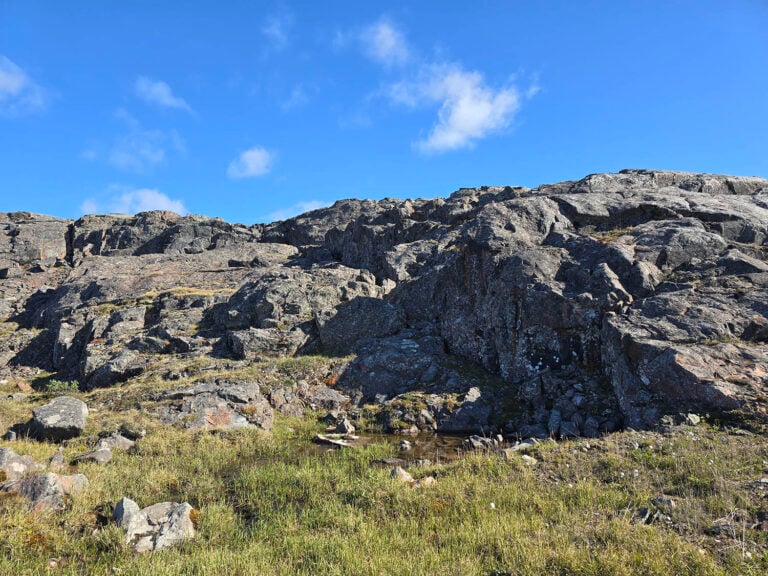
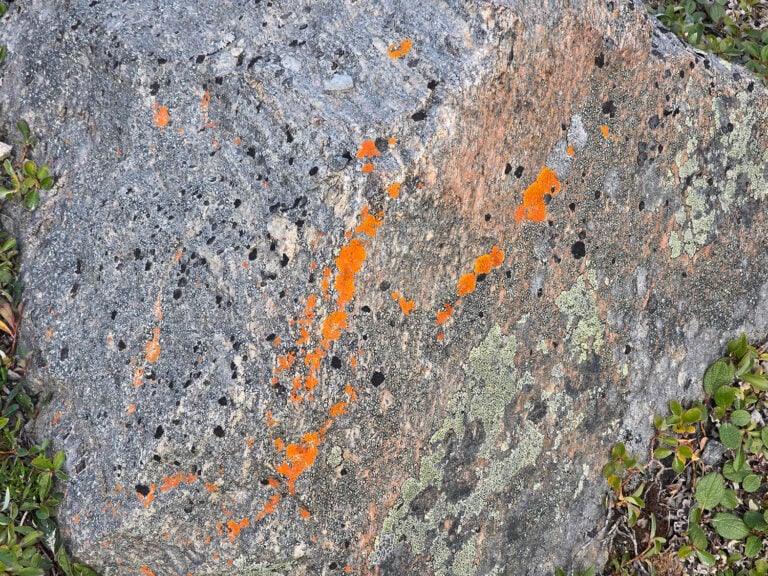
Hello, Joanne! Tell us a bit about where you travelled and the reason for your visit.
I traveled to Talurjuaq/Taloyoak, Nunavut (formerly Spence Bay, Northwest Territories) to visit with the surviving artists of Arnaqarvik ᐊᕐᓇᖃᕐᕕᒃ (“a place of women”), a collective formed in the early 1970s. They produced fashions, crafts, and artworks, and their hallmark was natural dye work.
We wanted to ensure their voices are heard in an exhibition Glenbow is planning for reopening and receive permission to show their artworks. The focus of the exhibition is the natural dye work the group pioneered – the first recorded instance of Arctic plants being used to create natural dyes in a collective enterprise. I also spoke with the children and even grandchildren of the artists, who helped gather lichen and plants and were often in the shop with their mothers and grandmothers as they worked.
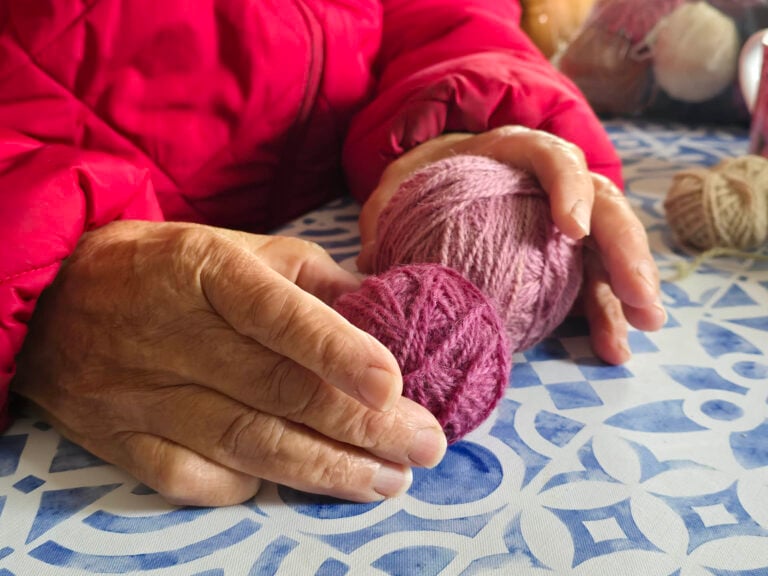
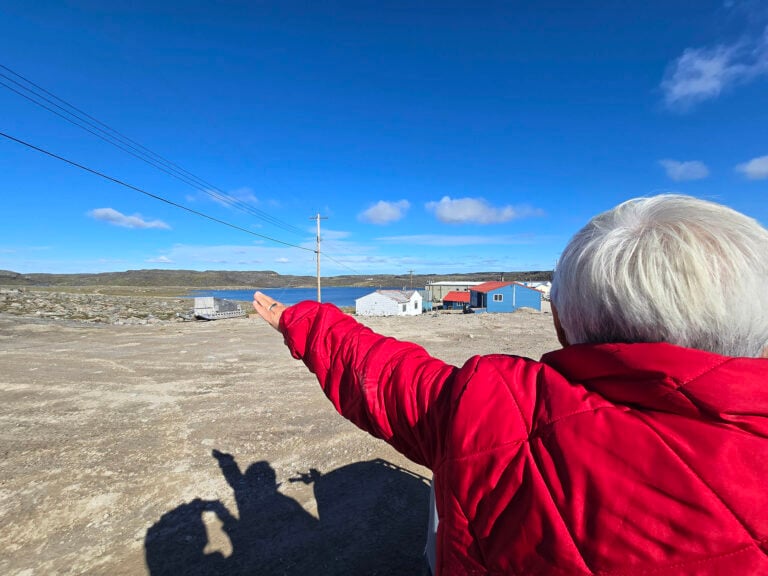
Tell us about the impact of Arnaqarvik ᐊᕐᓇᖃᕐᕕᒃ. What is its legacy today?
Judy McGrath and Anaoyok ᐊᕐᓇᐅᔪᖅ Alookee met in Talurjuaq/Taloyoak, Nunavut (then Spence Bay, Northwest Territories) in 1972, when Judy’s husband John relocated there as the community’s Economic Development Officer. Their friendship led to the establishment of a local craft industry that provided women a means to engage in the cash economy while practicing their traditional skills. The women of Talurjuaq/Taloyoak were able to explore and express their creativity, producing fashions, crafts, and artworks, with arctic natural dyes becoming a hallmark of their collective. They won national awards, international attention, and a way to preserve their land-based lifestyle while supporting their families.
The collective created a lasting legacy of pride among the women who participated, their children, and the community. Head designer Anaoyok ᐊᕐᓇᐅᔪᖅ Alookee was able to travel south to apprentice in the retail trade, interacting with customers and learning the costs of running a business. She then passed along her knowledge to the other artists, some of whom also traveled south to Toronto and Calgary for fashion shows and craft conferences. Many of the women learned to be self-reliant and used their skills to fit the new economy and way of life imposed on them.
Many of the children who participated by picking flowers and lichen expressed the pride they had in the strength and commitment of their mothers, and the pride and confidence it instilled in themselves.
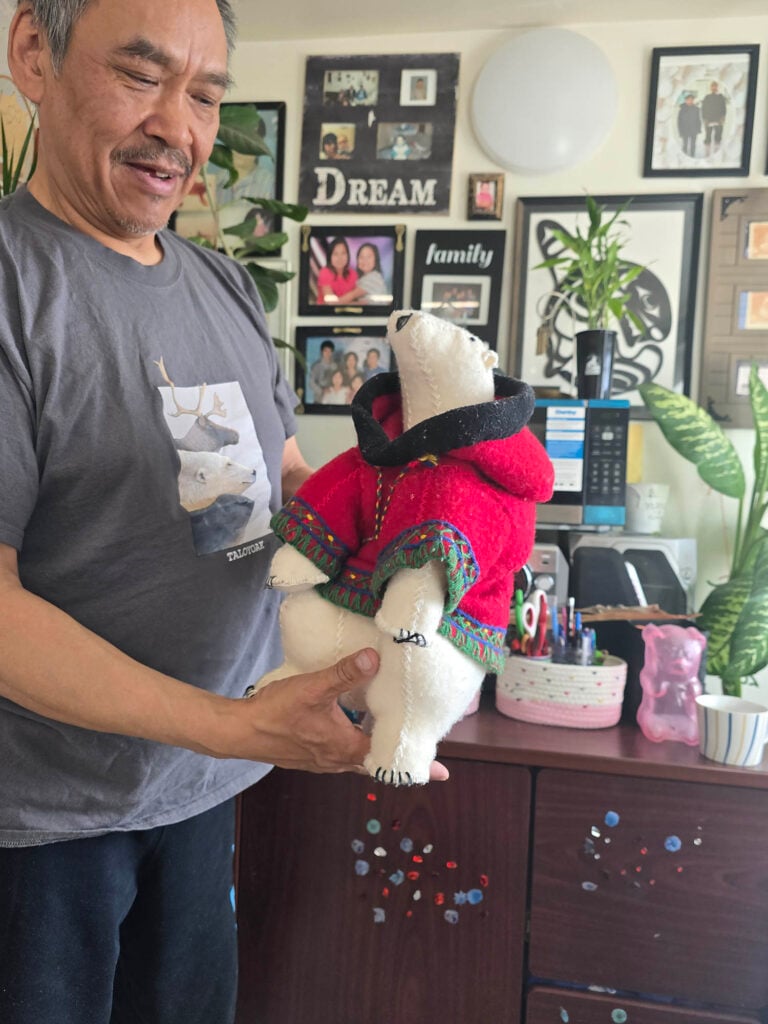
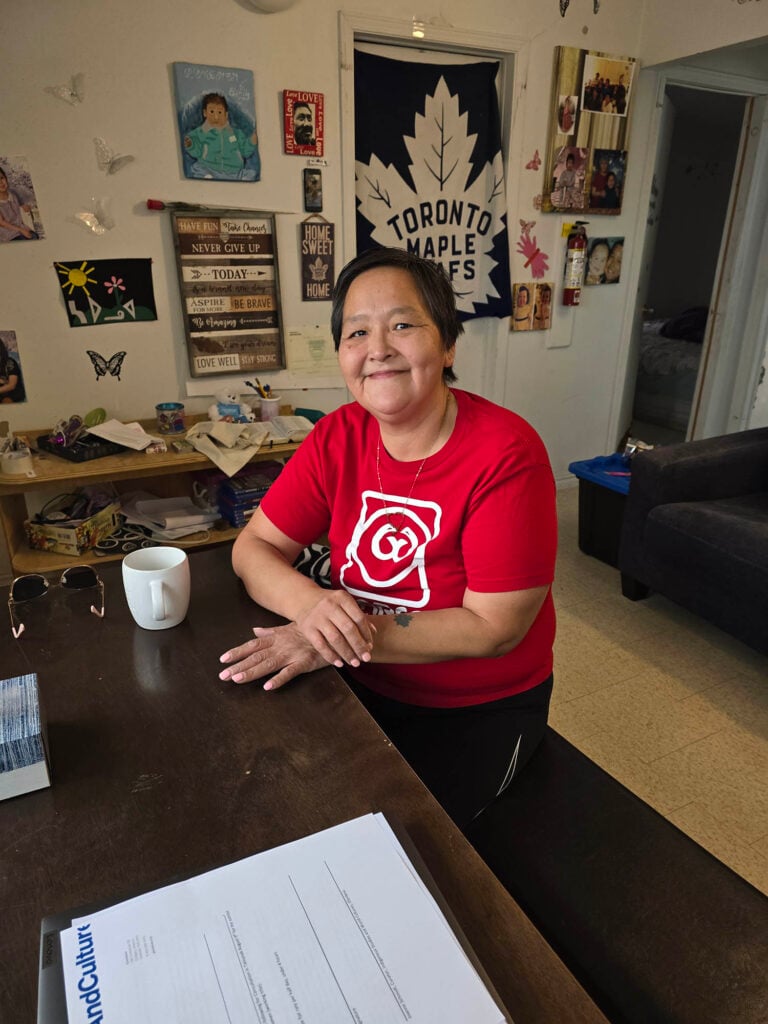
Your trip centered on meeting with community members – who did you meet and how did those connections come about?
While researching for an Inuit textile exhibition many years ago, I joined a Talurjuaq/Taloyoak Facebook group to learn more about the artists behind works stewarded by Glenbow. I met several of the children of artists through Facebook Messenger and re-introduced the community to the works at Glenbow. I kept in touch with many of them, including Jayko Neeveeacheak, the son of the late Eeteemunga Niviasiaq – one of the collective’s most prolific artists. It was exciting to chat with Jayko and learn about his memories from that time. I also met other artists and their children through Facebook and later research.
In researching for Glenbow’s new exhibition about the natural dye project, I came across a website that was the result of a collaboration between Judy McGrath, some of the artists, and the Kitikmeot Heritage Society. That website was instrumental in introducing me to more artists and the co-founders of the collective, as well as to Brendan Griebel, Manager of Collections, Archives, Facilities, and Technology at the Kitikmeot Heritage Society. Through that connection, I had several interviews with the late Arnaqarvik ᐊᕐᓇᖃᕐᕕᒃ co-founder Judy McGrath and her daughter, Janet. Judy then put me in touch with co-founder and head designer Anaoyok ᐊᕐᓇᐅᔪᖅ Alookee, with whom I chatted by phone, met at Judy’s celebration of life, and then in person in Talurjuaq/Taloyoak.
Before traveling to Talurjuaq/Taloyoak, I again posted on Facebook and connected with many people who were excited to tell their stories of the collective, either as artists or as children of artists. When I arrived in Talurjuaq/Taloyoak, the host I stayed with, Jeannie Ugyuk, called the radio station and we were immediately flooded with calls from community members who wanted to share their stories.
Other connections happened organically. As I walked around town, all kinds of community members stopped to chat – offering to introduce me to family members who were part of Arnaqarvik ᐊᕐᓇᖃᕐᕕᒃ or to translate, inviting me to their houses, and taking me out on the land and to the old craft shops.
How have community members been consulted throughout the exhibition development process?
Throughout the past few years of exhibition research, I’ve had phone calls, video calls, Messenger conversations, and other communication with the surviving artists and their children. At each step, I’ve shared information about the exhibition, discussed design elements, showed images of the artworks, and asked permission to display the artworks in the exhibition. Most importantly, I’ve asked which messages they want to share through the exhibition and listened carefully to their lived experience and perspectives – whether positive or negative.
Beyond the exhibition, I’ve asked how they would like their artwork remembered and cared for, and the most appropriate home for their artworks going forward. The women were excited to have their artwork stewarded by Glenbow so people “down south” would be able to learn about what they had accomplished. Glenbow also provided a list and images of the Arnaqarvik ᐊᕐᓇᖃᕐᕕᒃ collections we care for to the Kitikmeot Heritage Society to be included in an online knowledge bank.
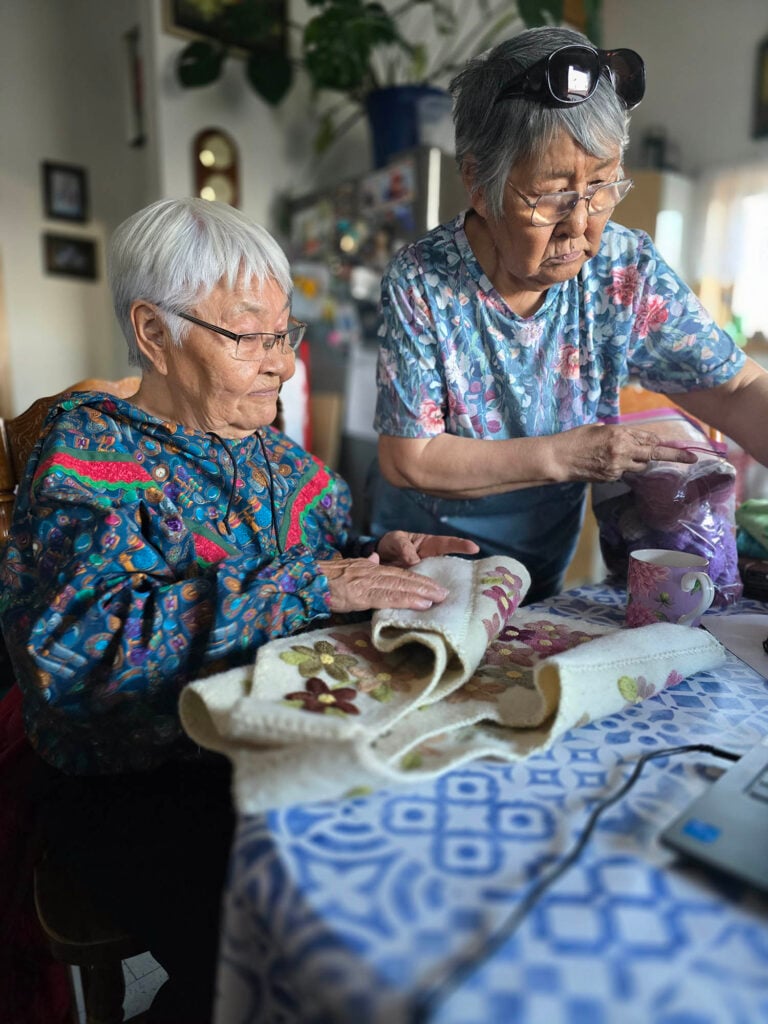
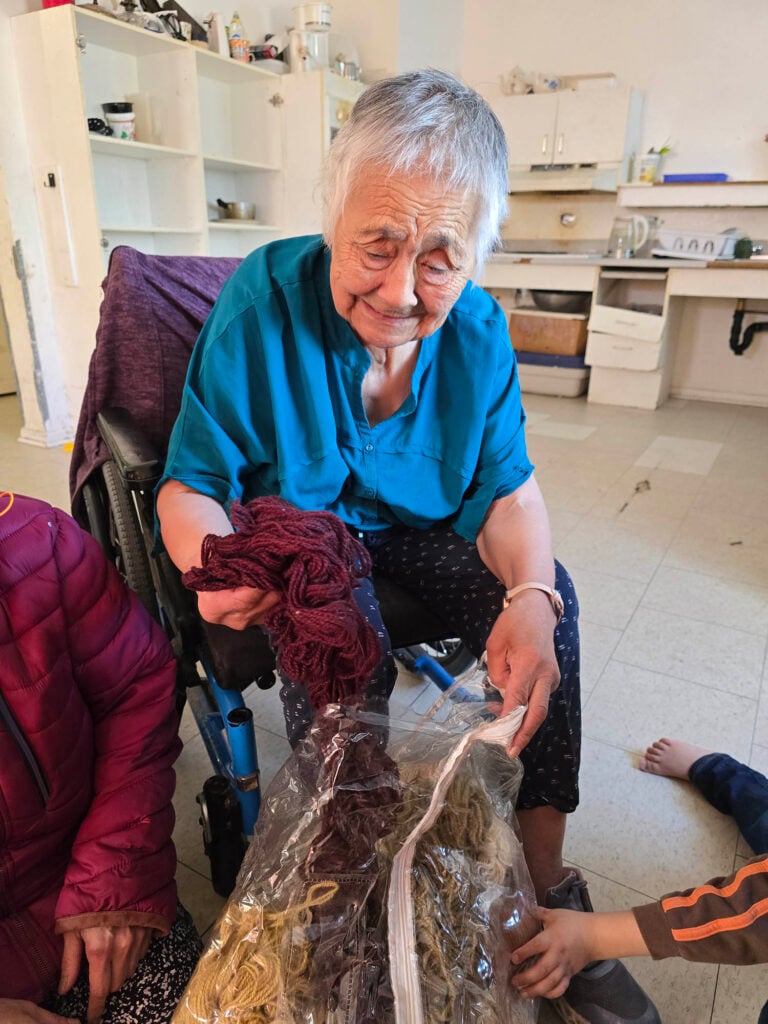
Were there particular moments or parts of the visit that left an impression on you?
There were so many, but the standouts were meeting four generations of the Alookee family. Anaoyok ᐊᕐᓇᐅᔪᖅ Alookee was the collective’s co-founder and head designer, and she traveled to New York City with sculptor Karoo Ashevak for his solo show in 1973 – while wearing natural dye fashions. She also managed the craft shop and was instrumental in its success. I met her daughter, Sandra Alookee, who had recently discovered sewing after being inspired by her mother. At her house, Sandra showed me her sewing projects with great pride. I also met Anaoyok’s granddaughter Wendy Alookee, who talked about how the strength, courage, and creativity of her grandmother made a powerful difference in her life – she is an excellent seamstress! Wendy said to me that she saw the interconnections, friendships, and relationships between the women as key to their success.
The other highlight was visiting Mary Qinqaktuk and her daughter. It was my last conversation shortly before I left for the airport. Mary spoke with great excitement and fondness about the collective and surprised me by bringing out a large bag of naturally dyed wool yarn she had carefully preserved in a dark place for over 50 years!
However, it would be a disservice to call these the highlights as every moment I spent chatting with artists and their children over tea, looking at artworks and photographs, meeting families, riding Hondas onto the land, and learning and listening were highlights. I am extremely grateful to everyone who opened their homes to me and shared their stories.
Are there stories or themes from the trip that will be reflected in the exhibition?
I would like to keep the stories as a surprise, but there were two themes that ran through every conversation.
One was the tremendous pride and astonishment of family members at the sheer volume of artworks, talent, and diversity of their mothers’ work. They all reflected on how their mothers didn’t really celebrate themselves, nor share the extent of their success. This exhibition will celebrate their success.
The second was that relationships, collaboration, cooperation, and connections were key to the collective’s success. These relationships will be a key focus in the exhibition and a focal point of many of the stories.
What do you hope visitors will take away from the exhibition?
I hope visitors will learn about the incredible upheaval of the Inuit way of life that resulted from being forced off the land into settlements, and how challenging it was to adapt. Despite this, through relationships and across cultures, the women created this unique, one-of-a-kind craft collective that instilled confidence, provided relief, and brought joy and pride, all while supporting their families. In a community of just 400 people at that time, a group of Inuit and southern women came together, learned from one another, and formed friendships that had lasting impacts.
While many today have no knowledge of this important moment in the history of Inuit art, these women produced some of the most stunning and memorable artworks, crafts, and fashions of the 1970s, including (exhibition spoiler alert!) the parka former Governor General of Canada Adrienne Clarkson wore in her official portrait.
Thank you, Joanne!
Glenbow’s work with the artists and families of Arnaqarvik ᐊᕐᓇᖃᕐᕕᒃ reflects our commitment to respectful stewardship of Indigenous art and stories. By building relationships with community members, Glenbow cares for collections in ways that honour the people and places from which they come. We look forward to sharing more about this exciting exhibition as we get closer to reopening!
